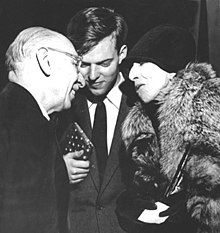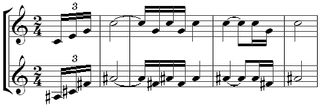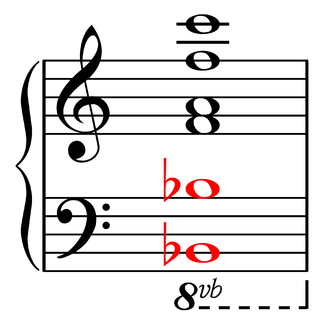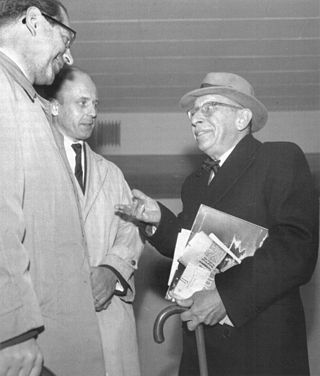
The Double Canon (Raoul Dufy in Memoriam) is a short composition for string quartet by Igor Stravinsky, composed in 1959. It lasts only about a minute and a quarter in performance.

The Double Canon (Raoul Dufy in Memoriam) is a short composition for string quartet by Igor Stravinsky, composed in 1959. It lasts only about a minute and a quarter in performance.
Although it is a memorial piece for the painter Raoul Dufy, who had died on 23 March 1953, the Double Canon is not a personal tribute, for the two men had never met. The work originated as a duet for flute and clarinet, composed in Venice in September 1959 as a souvenir piece in response to a request for an autograph. [1] Later expanded for string quartet, it had its first performance at a Stravinsky festival in New York, either on 20 December 1959, [2] or else on 10 January 1960 in a concert also featuring the premiere of the Movements for piano and orchestra. [3]
The Double Canon is exceptional in Stravinsky's twelve-tone compositions in that it uses transposed forms of the row. Stravinsky's habitual practice was to use only untransposed row forms. [4]
The first five notes of Stravinsky's series for the Double Canon are equivalent to the five-note set of In Memoriam Dylan Thomas, and also are closely related to sets used in Agon , Epitaphium , and A Sermon, a Narrative and a Prayer . It is representative of the earliest phase of Stravinsky's serial practice, when he had not yet developed the technique of hexachordal rotation that characterizes his music written from the Movements onward. [5] [6] [7]

Igor Fyodorovich Stravinsky was a Russian composer and conductor with French citizenship and United States citizenship. He is widely considered one of the most important and influential composers of the 20th century and a pivotal figure in modernist music.

Polytonality is the musical use of more than one key simultaneously. Bitonality is the use of only two different keys at the same time. Polyvalence or polyvalency is the use of more than one harmonic function, from the same key, at the same time.

The Rite of Spring is a ballet and orchestral concert work by the Russian composer Igor Stravinsky. It was written for the 1913 Paris season of Sergei Diaghilev's Ballets Russes company; the original choreography was by Vaslav Nijinsky with stage designs and costumes by Nicholas Roerich. When first performed at the Théâtre des Champs-Élysées on 29 May 1913, the avant-garde nature of the music and choreography caused a sensation. Many have called the first-night reaction a "riot" or "near-riot", though this wording did not come about until reviews of later performances in 1924, over a decade later. Although designed as a work for the stage, with specific passages accompanying characters and action, the music achieved equal if not greater recognition as a concert piece and is widely considered to be one of the most influential musical works of the 20th century.

Pandiatonicism is a musical technique of using the diatonic scale without the limitations of functional tonality. Music using this technique is pandiatonic.

Isang Yun, or Yun I-sang, was a Korean-born composer who made his later career in West Germany.

Canticum Sacrum ad Honorem Sancti Marci Nominis is a 17-minute choral-orchestral piece composed in 1955 by Igor Stravinsky (1882–1971) in tribute "To the City of Venice, in praise of its Patron Saint, the Blessed Mark, Apostle." The piece is compact and stylistically varied, ranging from established neoclassical modes to experimental new techniques. The second movement, "Surge, Aquilo", represents Stravinsky's first movement based entirely on a tone row.
Igor Stravinsky's Concerto in D ("Basle") for string orchestra was composed in Hollywood between the beginning of 1946 and 8 August of the same year in response to a 1946 commission from Paul Sacher to celebrate the 20th anniversary of the Basler Kammerorchester , and for this reason is sometimes referred to as the "Basle" Concerto.

The Flood: A musical play (1962) is a short biblical drama by Igor Stravinsky on the story of Noah and the flood, originally conceived as a work for television. It contains singing, spoken dialogue, and ballet sequences. It is in Stravinsky's late, serial style.
Agon is a 22-minute ballet for twelve dancers with music by Igor Stravinsky. It was choreographed by George Balanchine. Stravinsky began composition in December 1953 but was interrupted the next year; he resumed work in 1956 and concluded on April 27, 1957. The music was premiered in Los Angeles at UCLA's Royce Hall on June 17, 1957, conducted by Robert Craft. Stravinsky himself conducted the sessions for the work's first recording the following day on June 18, 1957. Agon was first performed on stage by the New York City Ballet at the City Center of Music and Drama on December 1, 1957.
A melodic line that is the reverse of a previously or simultaneously stated line is said to be its retrograde or cancrizans. An exact retrograde includes both the pitches and rhythms in reverse. An even more exact retrograde reverses the physical contour of the notes themselves, though this is possible only in electronic music. Some composers choose to subject just the pitches of a musical line to retrograde, or just the rhythms. In twelve-tone music, reversal of the pitch classes alone—regardless of the melodic contour created by their registral placement—is regarded as a retrograde.
In music, the "Ode-to-Napoleon" hexachord is the hexachord named after its use in the twelve-tone piece Ode to Napoleon Buonaparte Op. 41 (1942) by Arnold Schoenberg. Containing the pitch-classes 014589 it is given Forte number 6–20 in Allen Forte's taxonomic system. The primary form of the tone row used in the Ode allows the triads of G minor, E♭ minor, and B minor to easily appear.

The Octet for wind instruments is a chamber music composition by Igor Stravinsky, completed in 1923.
In music, a duodecet—sometimes duodectet, or duodecimette—is a composition which requires twelve musicians for a performance, or a musical group that consists of twelve people. In jazz, such a group of twelve players is sometimes called a "twelvetet". The corresponding German word is Duodezett. The French equivalent form, douzetuor, is virtually unknown. Unlike some other musical ensembles such as the string quartet, there is no established or standard set of instruments in a duodecet.

Abraham and Isaac is a sacred ballad for baritone and orchestra composed in 1962–63 by Igor Stravinsky.
"Epitaphium" is a short chamber-music composition by Igor Stravinsky, for flute, clarinet, and harp. The score was composed in 1959 and is inscribed in German, "Für das Grabmal des Prinzen Max Egon zu Fürstenberg". A performance last for less than two minutes.
The Septet for clarinet, bassoon, horn, piano, violin, viola and cello is a Chamber music composition by Igor Stravinsky. It was composed between July 1952 and February 1953, and the first performance took place at Dumbarton Oaks in Washington, D.C., on 23 January 1954. The score is dedicated to the Dumbarton Oaks Research Library and Collection. It consists of three movements, the first lacking a title, and the last lacking a number in the score. The work is influenced by twelve-tone technique, especially by the Wind Quintet, Op. 26, and the Suite for septet, Op. 29, composed by Arnold Schoenberg.

A Sermon, a Narrative and a Prayer is a cantata for alto and tenor singers, a narrator, chorus, and orchestra by Igor Stravinsky, composed in 1960–61. It belongs to the composer’s serial period, and lasts a little over a quarter of an hour in performance.
Sources